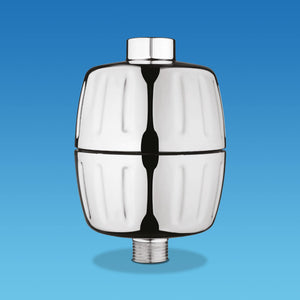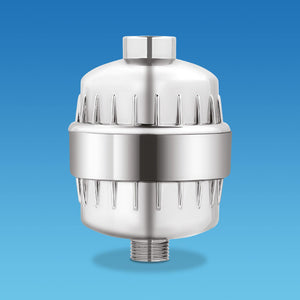So, are you someone who just loves to swim? Maybe you’re taking water aerobics classes, or maybe you just like to splash around (honestly, who doesn't?). But do you have dyed hair?
Maybe you’ve asked yourself, “How can I protect my dyed hair from chlorine without sacrificing either my color or my pool time?” Chlorine exposure can actually make hair color dull or even brittle, and if chlorine comes in contact with copper, it can even turn your hair color green.
Luckily, all it takes is just the right approach; yep, that's all! With that, you can keep your dyed hair healthy and gorgeous while enjoying the pool. That’s why this guide is here for you! You can pretty much expect to learn everything that there is to learn about protecting dyed hair, such as color-treated hair, harsh chlorine, and, yes, pool chemicals, too!
So, from pre-swim strategies to post-swim care, these tips will help prevent damage and color fading!
Understanding Chlorine’s Effect on Dyed Hair

Chlorine may keep pool water clean and free from bacteria, but its effects on hair are less than ideal. When you expose your hair to chlorine, especially in a chlorinated pool, it’s going to strip away your natural oils and weaken your hair stands, too.
Now, this leaves your hair far more prone to dryness and breakage, and yes, overall, it just has some damage, too. Dyed hair, particularly bleached hair, is even more susceptible due to its altered structure.
But here’s the thing: even beyond the damage, chlorine and chlorine chemical reactions can still wreak havoc on your hair color! Yes, you read that right! Now, it doesn’t even matter whether it’s fading vibrant artificial colors or turning blond hair green, but the chlorine chemical reactions with your hair are far from pretty.
It’s really far from pretty. Understanding these effects is the first step towards knowing how to prevent chlorine damage and maintaining your hair's natural moisture and beauty.
How Chlorine Harms Your Hair
For starters, chlorine’s job is to keep swimming pools clean by killing bacteria. But it’s not so friendly to your hair. In fact, chlorine strips away natural oils, drying out your hair strands and weakening their protective layer. Color-treated or bleached hair is particularly vulnerable since the artificial color and chemical treatments make your hair more porous.
Why Does Chlorine Change Hair Color?
Colored hair, especially if you have a lighter shade of hair (including bleached), can undergo some strange color transformations in chlorinated water, especially when it comes in contact with copper.
Have you ever noticed blonde hair turning green? You’ve probably heard about it at least once. Well, that’s because chlorine reacts with other pool chemicals, like copper compounds, which bind to your hair.
Over time, this exposure can keep you from vibrant colors and leave your hair dull.
Texture and Split Ends
Chlorine damages the outer cuticle of your hair, which can lead to a rough texture, split ends, and even hair breakage. If you swim or shower regularly, your hair’s natural moisture is constantly being stripped away, leading to long-term damage.
Pre-Swim Protection
Preparing your hair before you swim is like putting on sunscreen before heading into the sun. Yes, it’s essential for damage prevention! It’s only a few precautionary steps anyway; it's nothing major and time-consuming either.
You swim to have a good time, but preparing beforehand can pretty much give you a better time. If you take these steps, you can count on reducing the amount of chlorine that your hair absorbs and avoid the most severe effects of chlorine exposure.
There are a few ways to go about it; here’s what you should look into.
1. Rinse Hair with Clean Water

Yes, it’s really that easy! So, one of the easiest ways to minimize chlorine damage is to rinse your hair with clean water before swimming. Overall, wet hair absorbs less chlorinated pool water, reducing the amount of chlorine exposure your strands face.
2. Use a Leave-In Conditioner
A sulfate-free leave-in conditioner can act as a barrier between your hair and chlorinated water. You’ll just need to apply a pretty generous amount (more than dime-sized) to your damp hair before you take a dip. Ideally, you’re going to want to look into products specifically designed for color-treated hair to maximize protection.
3. Apply a Protective Oil
Oils like coconut oil or olive oil create a physical barrier on your hair strands, helping to lock in your hair's natural moisture. So, you’re going to want to apply a small amount to damp hair, focusing on the ends where most of the damage will occur.
4. Wear a Swim Cap
Many people don’t wear them because they don’t feel cute in a swimcap. Now, that’s really understandable, but do you want to know what else isn’t cute? It’s damaged hair or green hair!
Professional swimmers wear this so their hair isn’t damaged (yes, being aerodynamic helps, too), so shouldn’t you? Overall, waterproof swim caps provide the most protection, but even a regular cap can minimize contact with chlorinated pool water. Plus, for long hair, try a swimming cap designed specifically for larger hair volumes.
5. Use a Hair Mask Before Swimming
Hair masks aren’t just for repair; they can also provide pre-swim protection. A deep conditioning treatment applied before entering the pool can hydrate and shield your hair.
It’s the same for the protective oil and leave-in conditioner mentioned earlier. But don’t choose just any hair mask. Ideally, choose one that’s specifically meant for dyed hair or even damaged hair.
Post Swim Care
Even with the best pre-swim protection, it’s impossible to completely avoid chlorine exposure. That’s why post-swim care is just as important.
So, just removing chlorine from your hair as soon as possible prevents further damage while nourishing and repairing your strands, ensures they stay healthy and strong. It’s all about establishing a good post-swim routine that can make all the difference for color-treated hair.
- Rinse Hair Immediately After Swimming. Okay, so the sooner you rinse out that chlorine and all the other pool chemicals, the better! Use clean water to rinse your hair thoroughly as soon as you leave the pool. Note: if they are using a local water supply, you could still be exposed to chlorine in the rinsing shower.
- Use a Clarifying Shampoo. Clarifying shampoo removes what build-up (and lingering chlorine) that might be in your hair. You really need to use clarifying shampoo sparingly and try to look into sulfate-free formulas if you can.
- Deep Condition Regularly. After reducing chlorine with a clarifying shampoo, follow up with a deep conditioning treatment. This helps replenish moisture and restore your hair’s health. Ideally, you should choose a product designed for color-treated hair to repair damage and lock in your hair color.
Ongoing Hair Care Tips
Caring for dyed hair isn’t just about the pool days; sure, it’s a big part, but it’s not the only thing. You have to build up a strong routine if you want to have vibrant and healthy hair. Even if it’s not dyed, you still need that strong and consistent routine!
Avoid Excessive Heat Styling

You might already know this, but if you’re using blow dryers and curling irons, well, they’re going to amplify that chlorine damage.
Instead, you should look into old-fashioned air-drying your hair, or at least look into some super-reliant heat protectant spray if it’s absolutely necessary (but don’t make a habit out of using heat). You need to avoid heat if you want to preserve your hair.
Regular Trims
Split ends can spread up the hair shaft, leading to further damage. Plus, regular trims every 6 to 8 weeks prevent chlorine-damaged hair from becoming an even bigger problem.
Hydrate and Nourish Your Hair
Everyone who is into hair care already knows that moisturizing is key to healthy hair. Be sure to add that into your routine (and be strict about it too). Use hydrating hair masks, leave-in conditioners, or natural oils like argan or coconut oil to keep your strands soft and smooth.
Consult Your Hairdresser for Personalized Advice
If you’re unsure how to protect your specific hair type, ask your stylist. You can count on them to recommend the best products and techniques tailored to your dyed hair’s unique needs.
Using Shower Filters to Protect Dyed Hair

Did you know that chlorinated tap water could be sabotaging your hair care efforts? Yes, it’s true, and it’s far more common than you might think. Every time you wash your hair at home, chlorine and other chemicals in your shower water can strip away moisture and color.
So, it might be a good idea to just go ahead and look into installing a shower filter, which is an easy way to reduce chlorine exposure and maintain your hair’s vibrancy.
Chlorinated Water at Home
Did you know that your tap water could be damaging your hair, too? It’s not 100% guaranteed you’re dealing with this (as it does depend on your location and the water that’s being sourced), but the chlorine in the shower water can strip your hair of its natural oils.
This can lead to damaged hair and color fading over time, even if you’re not swimming in chlorinated water.
Benefits of Shower Filters
A shower filter reduces chlorine and other harmful chemicals in your water (including hard water), and it protects both your hair and skin. For those with dyed hair, this means less color fading, and yes, you’ll get to keep hydrated hair, too.
AquaBliss Shower Filters

Where can you get these amazing shower filters? How do you know you’re getting something that even works? AquaBliss shower filters are designed to minimize chlorine exposure, making them a must-have for anyone with color-treated hair.
By investing in a shower filter, you’re extending the life of your hair dye, and you’re keeping the strands healthy. Shop AquaBliss Shower Filters Now!
Fixing Chlorine-Damaged Hair
Alright, so if your hair is already showing signs of chlorine damage, well, it’s a pretty solid sign that it’s time to focus on repairing it.
1. Clarifying and Deep Conditioning
You’re going to want to start by using a clarifying shampoo to remove chlorine, followed by a deep conditioning treatment. Why do this? Well, you can count on this combo to help you out when it comes to restoring your hair's moisture and health.
2. Try a Hair Mask
Hair masks are designed for damaged or color-treated hair, and yes, they can work wonders! Go ahead and look for one with nourishing ingredients like keratin or argan oil.
3. Natural Remedies
Are you someone who likes to go all natural? Would you rather save some money and use what you have in the pantry? Well, that’s totally understandable, as some people prefer to save some money with the DIY approach.
All you need to do is rinse your hair with apple cider vinegar or apply a coconut oil treatment. Both of these methods can help restore your hair’s natural oils and reverse the drying effects of chlorine.
Ready to Save Your Hair?
Chlorine doesn’t have to mean the end of vibrant and healthy hair. So, just by following these tips (and yes, that includes getting the AquaBliss shower filters), you can protect your dyed hair from chlorine and enjoy beautiful hair all year round! Start your hair protection journey today with AquaBliss Shower Filters. Your hair will thank you!







